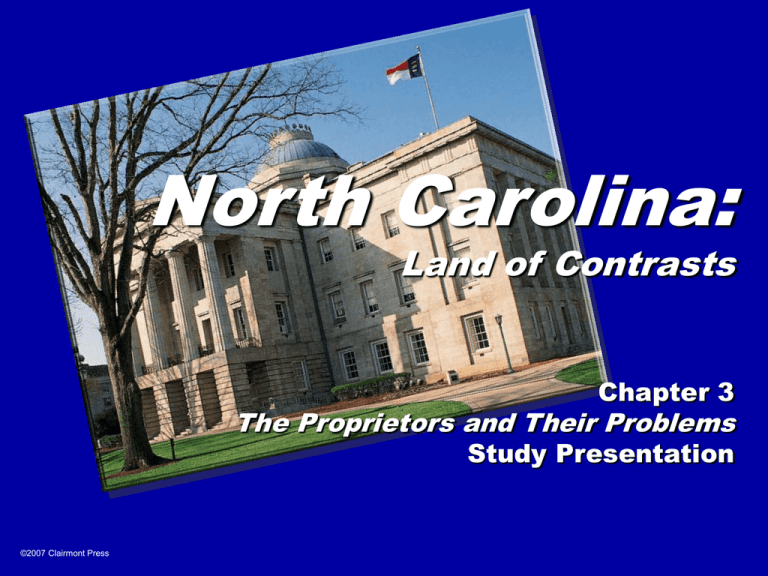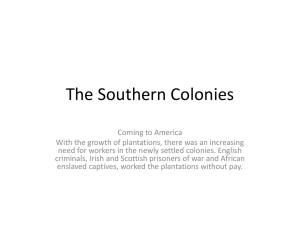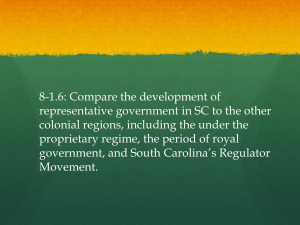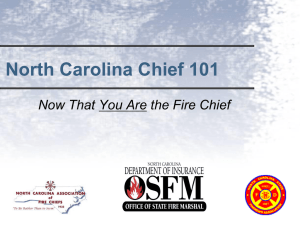File - Mrs. Stevens 8th grade Social Studies
advertisement

North Carolina: Land of Contrasts Chapter 3 The Proprietors and Their Problems Study Presentation ©2007 Clairmont Press Chapter 3: The Proprietors and Their Problems • • • • • Section 1: Settling the Albemarle Sound Section 2: The Chartering of Carolina Section 3: Culpeper’s Rebellion Section 4: Settling the Pamlico Sound Section 5: Settling the Cape Fear Section 1: Settling the Albemarle Sound ESSENTIAL QUESTION – How did the geography of North Carolina affect its early development? Section 1: Settling the Albemarle Sound What words do I need to know? 1. neck 2. speculate 3. customs duty Section 1: Settling the Albemarle Sound Introduction • “Necks” (peninsulas) along the Albemarle Sound were early neighborhoods for European settlement • 1650s-1700s: North Carolina governed by English Lords Proprietors • English leaders and colonists often did not get along Settlers from the North • 1629: King Charles I gave large section of lands south of the Great Dismal Swamp to Sir Robert Heath; this grant was not used, however • George Durant, Richard and Nathaniel Batts were early settlers • Virginians moved south to Carolina for the chance to grow more tobacco with less effort (good soil) and expense (free land) • Early settlers “speculated” that Carolina lands would one day be as profitable and expensive as Virginia’s Carolina “Rogues” • Durant and others were known as rogues (cheaters) because they exported their tobacco and other crops without paying the export tax (customs duties) • By mid-1660s, settlers were doing well • Location allowed growing of corn and wheat to sell to English merchants • It was undetermined whether these settlers were part of Virginia or another colony Click here to return to Main Menu. Section 2: The Chartering of Carolina ESSENTIAL QUESTION – How did Carolina become a separate colony? Section 2: The Chartering of Carolina What words do I need to know? 1. charter 2. Lord Proprietor 3. quit-rent Section 2: The Chartering of Carolina Introduction • charter: a contract by the king to individuals or groups to be in charge of a colony’s settlement • 1663: King Charles II gave lands of southern Virginia to some of his supporters • The lands were called Carolina, after King Charles I, and the leaders were eight Lords Proprietors (rulers and owners of the property) • 1665: Charter expanded to include lands that are now South Carolina, Georgia, and northern Florida and west to the Pacific Ocean! The Lords Proprietors • The Proprietors were among the most powerful men in England • Proprietors planned to sell the land inexpensively, then make money from a property tax called a quit-rent • Part of the quit-rent paid the colony’s expenses; the Proprietors kept the rest • Albemarle Sound named for the Duke of Albemarle (commander of the English army) • Two rivers named for Sir Anthony Ashley-Cooper (national treasurer) – Charles Town established where the Ashley and Cooper rivers met The Lords Proprietors – cont. • 1669: Fundamental Constitutions approved by Proprietors • Called the “Grand Model”: created a class system for the colony similar to England’s • Albemarle began to be less profitable as Charles Palatine High class Town area found fortune Caciques growing rice Landgraves • Poor access to the sea Yeoman Lower class hurt Albemarle Social and Economic Conditions • Most Albemarle settlers poorer than those of Virginia • Houses were wood frame huts held together with wooden pegs • No plows for farms, only hoes and shovels • Men sometimes called “lubbers”; had a reputation for laziness • Few churches – people worshipped in their homes • 1672: “Society of Friends” (Quakers) new religious group from England –believed in worship without a minister • Independent style of the Quakers suited many • Proprietors had difficulty getting the quit-rents from the independent Albemarle lubbers Click here to return to Main Menu. Section 3: Culpeper’s Rebellion ESSENTIAL QUESTION – How did issues about taxation cause problems between the Albemarle residents and the Proprietors? Section 3: Culpeper’s Rebellion What words do I need to know? 1. 2. 3. 4. 5. General Assembly Navigation Acts Culpeper’s Rebellion governor treason Section 3: Culpepper’s Rebellion Introduction • 1668: Great Deed of Grant – approved by the first Carolina General Assembly and the Proprietors – stated that all existing land deeds would be honored and quitrents would be the same as Virginia’s • 1673: Navigation Acts enforced by Proprietors – taxed exported items such as tobacco, fish, flour, and shingles • The Acts were designed to bring more money to the King • Most Albemarle residents ignored the tax or worked to avoid paying it • Thomas Miller and Thomas Eastchurch supported the tax as a way to earn money for themselves The Beginnings • 1675: Miller and Eastchurch visit the Proprietors in England to discuss the “deplorable conditions” • George Durant defended the colonists, saying they were too poor to pay the taxes • Eastchurch was made governor; Miller was made tax collector • Durant threatened to rebel • Eastchurch delayed his return to return to Carolina to be married; Miller was sent on to take charge Miller the Tyrant • 1677: Miller arrived back in Carolina with an armed ship – he began arresting and fining anyone he did not like • Durant arrived later, distributing weapons around Durant’s Neck • Miller and his followers were imprisoned by Durant’s group • Governor Eastchurch arrived, but got sick and died before the problems were resolved • The Proprietors sent several governors to the Albemarle, but few quit-rents made their way to England Durant and Friends Win • 1680: a hearing was held to determine the source of problems in the Albemarle – Miller was blamed • Virginia began to claim the Albemarle and demanded the quit-rents • 1683: Governor Sothel arrived, behaving as if the colony were his private estate and punishing or jailing those who disagreed with him • 1691: The frustrated Proprietors split the colony; the governor moved to Charles Town where customs duties on rice exports were high • The “north” Carolina region had a deputy governor, George Archdale, a Quaker who generally left the people alone Click here to return to Main Menu. Section 4: Settling the Pamlico Sound ESSENTIAL QUESTION – How did the Proprietors try to use religion to gain control in North Carolina? Section 4: Settling the Pamlico Sound What words do I need to know? 1. county 2. refugee 3. cede Section 4: Settling the Pamlico Sound Introduction • In order to get more colonists, the Proprietors offered cheap land to refugees from European wars • 1696: Governor Archdale divides Albemarle into two counties • Ocracoke Island grew due to its location near Atlantic shipping lanes • Virginia sought a law forbidding its citizens from moving to the Pamlico First Towns • The Pamlico’s first towns were Bath (1705) and New Bern (1711) • Bath was named for an English seaport • New Bern named after Bern, Switzerland – the new town’s first residents came from Europe seeking religious freedom • Queen Anne helped pay for the refugees’ trip to America Cary’s Rebellion • 1701 & 1703: In order to better organize the colony, the Proprietors tried religion • North Carolina was divided into parishes • English parishes had one church – everyone in the parish was baptized, worshiped, married, and was buried in their parish church • Church of England = Anglican Church • All citizens officially belonged to the church, whether they wanted to or not – had to pay church taxes in addition to quit-rents • 1704: Test Act – General Assembly said any office holder must swear an oath to uphold the Anglican Church Cary’s Rebellions – cont. • Governor Cary used Test Act to keep Quakers from holding office • Quakers were good, tax-paying citizens and appealed to the Proprietors • A new governor was sent, and angry North Carolinians prepared for a fight • Cary joined the Quakers and fought for his job – made himself governor 1708-1711 and let Quakers hold office • 1711: Edward Hyde arrived as new governor – with the help of English soldiers, he threw out Cary and his followers and restored the Anglican Church The Tuscarora War • 1711: Tuscarora Indians tried to destroy Pamlico settlements • Several hundred colonists killed • Tuscarora were angered by: – – – – loss of their land loss of hunting lands cheating by white traders kidnapping of Indians to sell as slaves • Virginia refused to send troops to assist unless Governor Hyde gave back lands north of Albemarle Sound • South Carolina troops arrived – mostly Indians who did not like the Tuscarora The Tuscarora War – cont. • Colonel John Barnwell achieved a temporary compromise, but it was not supported by the General Assembly • 1712: The Tuscarora attacked again during a yellow fever outbreak • 1713: James Moore of South Carolina defeated the Tuscarora – Indians were forced into slavery or left the region • 1712: Proprietors officially separated North and South Carolina • 1715: North Carolina revised all its laws; oaths to the Anglican church were now avoidable, however, the quit-rents remained Click here to return to Main Menu. Section 5: Settling the Cape Fear ESSENTIAL QUESTION – How and why were the lands of Cape Fear settled? Section 5: Settling the Cape Fear What words do I need to know? 1. naval stores 2. bounty 3. royal colony Section 5: Settling the Cape Fear Introduction • Defeat of the Tuscarora opened new lands for settlement in the Cape Fear region • Settlers hoped to grow rice and sell naval stores (pitch, turpentine, and tar from longleaf pines were needed to keep ships from leaking) • Millions of acres of longleaf pine were available • 1723: Maurice and James Moore led settlers into the region • They paid their quit-rents in advance to Governor Burrington of North Carolina in order to gain access to the lands Blank Patents • Governor took land deeds (blank patents) to the mouth of the Cape Fear, sold them to the Moore’s and others, and let them fill in the blanks about the land at a later time • The Moores and their families took over 80,000 acres – became known as “the Family” • The frustrated Proprietors decided to sell out their interest in the annoying colony The End of Proprietorship • 1729: King George II bought back North and South Carolina – now “royal colonies” • Lord Granville refused to give up his oneeighth interest in the colonies • The king ruled the whole colony, yet received seven-eights of the taxes Click here to return to Main Menu. Click here to return to Main Menu.









